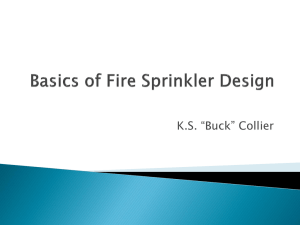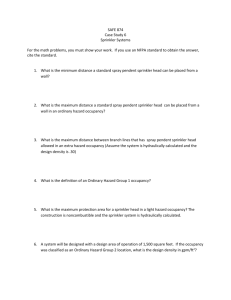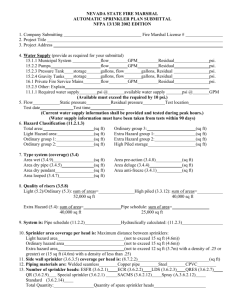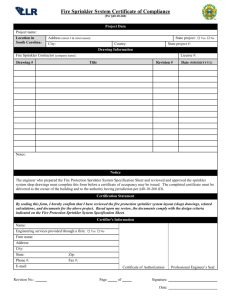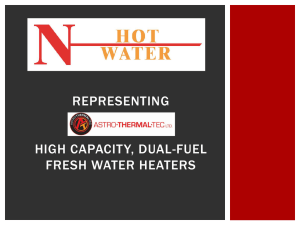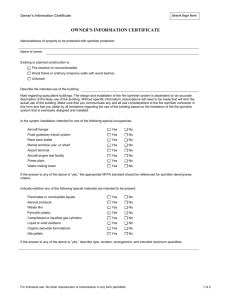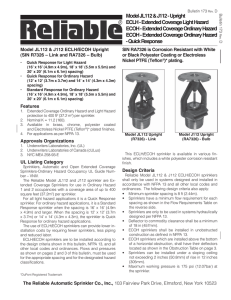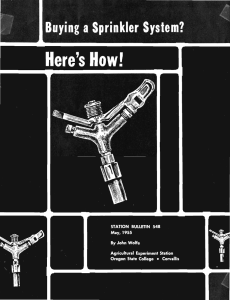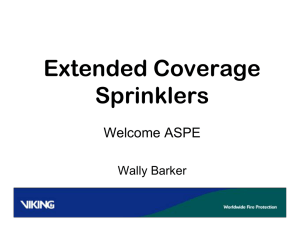FUNDAMENTALS OF WATER
advertisement
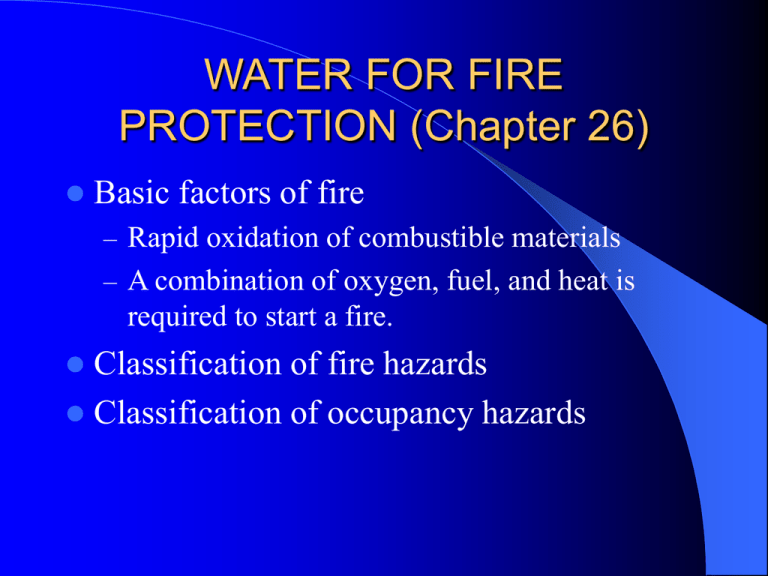
WATER FOR FIRE PROTECTION (Chapter 26) Basic factors of fire – Rapid oxidation of combustible materials – A combination of oxygen, fuel, and heat is required to start a fire. Classification of fire hazards Classification of occupancy hazards WATER FOR FIRE PROTECTION (Additional information) Objectives in fire safety – Protection of life Evacuation of people the time interval between detection of fire and arrival of fire fighters. Providing adequate number of fire exits and clearly defined access (i.e. corridors, hallways, etc.) to exits. – Absolute minimum width of an exit access is 28". – In order to accommodate adults using various walking aids, corridors should be at least 36" wide. The standard unit of exit width computation is 22" (i.e. 22" = 1 exit unit). – Exit Width Units = Floor area of the building in sq. ft./(occupant density in sq. ft./person)* (Capacity per unit of exit width) WATER FOR FIRE PROTECTION (Additional information) Minimum exit requirements: – – – – – Basement: 2 Every building floor: 2 Building with 50 occupants or more: 2 Building with 500 occupants or more: 3 Building with 1,000 occupants or more: 4 Maximum distance of a fire exit from any part of the building – 100 to 200 ft. for unspriklered spaces – 150 to 300 ft. for sprinklered spaces. – Protection of property – Continuity of operation WATER FOR FIRE PROTECTION Methods for fire detection Methods of fire control – Standpipe systems – Automatic sprinkler systems Piping design – – – Hydraulic method: Hazen-Williamson formula Use of piping schedule Flow rate of sprinklers Sprinklers on a branch line Protection area per sprinkler Maximum spacing between sprinklers DESIGN OF SPRINKLER SYSTEMS (Additional information) Residual pressure of the sprinkler system – – pressure remaining in a system while water is being discharged from the outlets sprinkler systems are usually designed for a maximum working pressure of 175 psi. Density of Water Flow (D) – required water flow from a sprinkler in gallons per square foot of area of operation Light hazard: 0.07 to 0.1 gpm/sq.ft. Ordinary hazard: 0.1 to 0.2 gpm/sq.ft. Extra hazard: 0.2 to 0.4 gpm/sq.ft. Size of sprinklers – Find required flow rate (in gpm) of a sprinkler (Density of water flow * Maximum coverage) – Find out k-factor to determine the size of the sprinklers Q = K* p, where Q = flow rate in GPM, K = flow constant of sprinklers, p = residual pressure in psi Determine the size of the piping system – Use the method for sizing water supply pipes (either pipe sizing formula or piping schedule) Sprinkler head sizes (Additional information) K-factor Nominal orifice size in inch 1.3-1.5 ¼ 1.8-2.0 5/16 2.6-2.9 3/8 4.0-4.4 7/16 5.3-5.8 ½ 7.4-8.2 17/32 11.0-11.5 5/8 13.5-14.5 ¾ WATER FOR FIRE PROTECTION (Additional information) Water demand for fire suppression – Area of Sprinkler Operation (ASOP) Only a small part of the sprinkler systems need to be operated during the early stage of fire. Codes, therefore, require only a small area of the building to be calculated for simultaneous flow demand. This area, called the area of sprinkler operation (ASOP), for different hazard classifications is as follows: – Light: 1500 - 3000 sq. ft. – Ordinary: 1500 - 4000 sq. ft. – Extra: 2500 - 5000 sq. ft. WATER FOR FIRE PROTECTION (Additional information) – Density of Water Flow (D) required water flow from a sprinkler in gallons per square foot of area of operation – Light hazard: 0.07 to 0.1 gpm/sq.ft. – Ordinary hazard: 0.1 to 0.2 gpm/sq.ft. – Extra hazard: 0.2 to 0.4 gpm/sq.ft. – Hose Stream Demand (HSD) water demand of hoses, both inside and outside – Light hazard: 100 gpm – Ordinary hazard: 250 gpm – Extra hazard: 500 gpm – Overage Factor (OVF) Usually 1.1 – Total Water Demand in gpm = ASOP * D * OVF + HSD Other methods of fire suppression Carbon dioxide Dry chemicals Foam systems Halogenated agents
